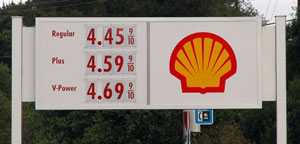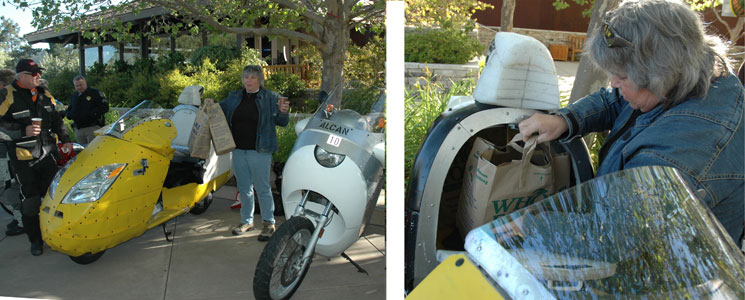 | |||||||||||||||||||||||||||||||||||||||||||||||||||||||||
| The route was a 133.5 mile loop beginning and ending at Carmel, CA. The route out was mountainous, cresting a 2500 ft pass. The route back was Highway 101 - the famous El Camino Real. Speeds were well over 70 mph, into fierce, 30 mph+ winds. This was a very challenging day. | |||||||||||||||||||||||||||||||||||||||||||||||||||||||||
 | |||||||||||||||||||||||||||||||||||||||||||||||||||||||||
 | |||||||||||||||||||||||||||||||||||||||||||||||||||||||||
| Gordon McCall conducts the Riders' Meeting | |||||||||||||||||||||||||||||||||||||||||||||||||||||||||
| The winner would be the one who met the conditions of the Challenge and consumed the least fuel in dollars and cents. | |||||||||||||||||||||||||||||||||||||||||||||||||||||||||
 |  | ||||||||||||||||||||||||||||||||||||||||||||||||||||||||
| Fred Hayes consumed $4.53 in Bio-Diesel in the 133.5 mile Quail Ride. It cost the owner of the 1975 GL1000 over $16 for the same trip. Even more impressive, half of the course was running around 60 mph up and over a mountain pass. The return was grueling with speeds over 70 mph into headwinds over 30 mph! Such winds feel like 100 mph. | |||||||||||||||||||||||||||||||||||||||||||||||||||||||||
| Think about 133 miles in these conditions. Then think about doing it on one gallon of fuel. That is what Fred Hayes did. Lets take a look at the preliminary results: | |||||||||||||||||||||||||||||||||||||||||||||||||||||||||
 | |||||||||||||||||||||||||||||||||||||||||||||||||||||||||
| The first thing I notice is that the most horsepower burns the most fuel | |||||||||||||||||||||||||||||||||||||||||||||||||||||||||
 | |||||||||||||||||||||||||||||||||||||||||||||||||||||||||
| The way we rode: A Leader and the Challengers in between me at the rear. | |||||||||||||||||||||||||||||||||||||||||||||||||||||||||
 | |||||||||||||||||||||||||||||||||||||||||||||||||||||||||
| To be considered a winner, the machines must stay with the leader - at the speed he sets - and stay in front of me. If they do not stay in front of me they disqualify themselves. In the Quail Challenge, two were disqualified for going too slow. They had to be able to carry four bags of groceries. Only three of the top bikes entered at the Quail could carry the groceries, which leads us to the Winners: | |||||||||||||||||||||||||||||||||||||||||||||||||||||||||
 | |||||||||||||||||||||||||||||||||||||||||||||||||||||||||
| Do you see what I see? Diesels seem to have more potential than gas motors. We had no electric bikes at the Quail but expect them at Mid Ohio. Then what? This is exciting stuff. | |||||||||||||||||||||||||||||||||||||||||||||||||||||||||
 | |||||||||||||||||||||||||||||||||||||||||||||||||||||||||
| Next, lets take a look at each of the top machines to see how they did it. Can you tell how proud I am of these guys? | |||||||||||||||||||||||||||||||||||||||||||||||||||||||||
 | |||||||||||||||||||||||||||||||||||||||||||||||||||||||||
| First Place: Fred Hayes MD670F2 Diesel 3.34¢ per mile; 128 mpg $4.53 670cc, 31 hp @5,300 rpm; 35 ft lbs torque@2,300 rpm | |||||||||||||||||||||||||||||||||||||||||||||||||||||||||
 | |||||||||||||||||||||||||||||||||||||||||||||||||||||||||
| A gallon of bio-Diesel to go 133 miles into powerful headwinds at 70 miles per hour | |||||||||||||||||||||||||||||||||||||||||||||||||||||||||
| Has anybody come close to doing this? I don't think so. If you think you can, meet us at Ohio this July. Fred plans to ride from California to Ohio and would like to meet you. In the short time this page has been under construction, the big question has been: "How did Fred carry the groceries?" | |||||||||||||||||||||||||||||||||||||||||||||||||||||||||
 | |||||||||||||||||||||||||||||||||||||||||||||||||||||||||
| Actually, no one had to carry the groceries on the Quail ride As Charly Perethian observed, Fred and the others had a "one time free pass". The rules have been tightened up for Mid Ohio. Fred brought a set of nicely finished saddlebags made of aluminum. Carol brought the groceries. We all watched as the Hayes saddlebags swallowed up four bags. The rules as written for the Quail did not require the groceries to be carried on the ride so the Hayes Diesel was technically "in compliance." Here is how it will be at Mid Ohio: "If any part of the bags are exposed, you will have to ride with the filled bags. The reason is this: If the groceries are within a streamlined enclosure, they will not affect the mileage. If they are exposed, they will be aerodynamically "dirty" and consume more fuel as you go through the air. If you are going to leave your grocery bags exposed, you will pay the price in increased fuel consumption." Make sense? | |||||||||||||||||||||||||||||||||||||||||||||||||||||||||
| Fred Hayes talks: "Hayes Diversified Technologies is a very small company with just four employees. Our new bikes are based on modified Kawasaki KLR650 rolling chassis, just like our military bikes. www.dieselmotorcycles.com | |||||||||||||||||||||||||||||||||||||||||||||||||||||||||
| The current bikes have modified suspensions that provide a lower CG and seat height. Noleen J6 modified the front forks and provides the shortened rear shock. We run Dunlop GT501s front and rear and use AMSOIL 5w-30 diesel rated oil in the engine/transmission. The fairing is the John Cronshaw fairing available from AirTech. The fuel is commercially available B20 with Biotane refined waste vegetable oil. The Biodiesel we used is the same fuel we used to set our Land Speed Records. Needless to say, the bikes start, stop, turn, and shift very well. The only problem I had with the run is remembering I was in a fuel mileage contest, not a performance contest. The bikes weight about 370 lbs dry, but with the low CG, they feel lighter." Fred.... |  | ||||||||||||||||||||||||||||||||||||||||||||||||||||||||
| | |||||||||||||||||||||||||||||||||||||||||||||||||||||||||
 | |||||||||||||||||||||||||||||||||||||||||||||||||||||||||
| Second Place: Alan Smith 2005 Ninja 250 4.75¢ per mile; 93mpg $6.43 250cc, 28 hp @12,000 rpm; 18 ft lbs torque@10,000 rpm | |||||||||||||||||||||||||||||||||||||||||||||||||||||||||
 | |||||||||||||||||||||||||||||||||||||||||||||||||||||||||
| Alan had no problem packing Carol's four bags into his streamlined tail section. He had to squish them a little, but he did it. Alan kindly provided this about his Ninja 250 streamliner: "After the previous year’s competition with a Honda CRF230L streamliner, I felt it would be to much work to solve the cooling problems of the air cooled engine. Also I learned a lot of what to do and what not to do when building a streamliner. I figured it would be easier to start all over on a new motorcycle. I was impressed with last year’s Ninja 250 powered 3-wheel HyperRocket’s fuel economy so I decide to try a Ninja 250. This year’s Ninja 250 project would be much simpler because of short time to build it and I wanted to actually do some long distance rides with it. So a less radical approach was done this year. I purchased a used 2005 Ninja 250 last February. It was a three month effort to build the enclosed front wheel, extend the windshield, and build an aerodynamic trunk. I would say that the trunk took the most work. The only mechanical changes to the Ninja 250 were changing the sprockets from 14/45 to 15/37. Also the O-ring chain was replaced with a non O-ring chain. This fall I plan to make more improvements." | |||||||||||||||||||||||||||||||||||||||||||||||||||||||||
 | |||||||||||||||||||||||||||||||||||||||||||||||||||||||||
| Last year, Alan challenged me with his CRF230. If the headwinds were strong, I could beat him, consuming less fuel. If not, he could beat me. Movie. The weak point of his CRF was its air cooling. Going fast into the headwinds, he had to spray water from a bottle onto its cylinder head to keep it cool. This is why he began over with a liquid cooled bike. | |||||||||||||||||||||||||||||||||||||||||||||||||||||||||
| | |||||||||||||||||||||||||||||||||||||||||||||||||||||||||
| The 3rd place Vetter Streamliner 1994 Honda Helix 5.03¢ per mile; 88 mpg $6.82 | |||||||||||||||||||||||||||||||||||||||||||||||||||||||||
 | |||||||||||||||||||||||||||||||||||||||||||||||||||||||||
| Forty years of streamlining and reduced horsepower | |||||||||||||||||||||||||||||||||||||||||||||||||||||||||
| Bob Roach's 1975 GL1000 and Windjammer 34 mpg $16.36 1000cc, 78 hp @7000 rpm | Third Place: Craig Vetter 1994 Honda Helix 88 mpg $6.82 250cc, 17 hp @7,500 rpm; 15.5 ft lbs torque@5,000 rpm Why doesn't the Helix do better? Probably it is because of the CVT. | ||||||||||||||||||||||||||||||||||||||||||||||||||||||||
| I show you this picture because it represents 40 years of Vetter Fairing Design evolution. In the 70s, the Windjammer equipped GL 1000 was the last word in motorcycle touring comfort. But, can we continue to guzzle fuel at this rate? Look what happens when we streamline and reduce our horsepower. More comfort. More storage. Less fuel cost. Lighter. Easier to push around. No carbs to sync. If fuel ever becomes precious, this is the design formula. Everything is better. Actually, everything is better even if fuel never becomes precious. | |||||||||||||||||||||||||||||||||||||||||||||||||||||||||
| Carol had to be sure that four bags of groceries would fit in her husband's machine: | |||||||||||||||||||||||||||||||||||||||||||||||||||||||||
 | |||||||||||||||||||||||||||||||||||||||||||||||||||||||||
| This web site is filled with the making of the Vetter Streamliner. | |||||||||||||||||||||||||||||||||||||||||||||||||||||||||
| | |||||||||||||||||||||||||||||||||||||||||||||||||||||||||
| Treven Baker's home-made Diesel Challenger | |||||||||||||||||||||||||||||||||||||||||||||||||||||||||
 | |||||||||||||||||||||||||||||||||||||||||||||||||||||||||
| We should all try this at home. I don't mind telling you that the arrival of this strange machine got our attention. What was this? Well, it was made by an enthusiast in nearby Santa Cruz named Treven Baker. His explanation is below: | |||||||||||||||||||||||||||||||||||||||||||||||||||||||||
 | |||||||||||||||||||||||||||||||||||||||||||||||||||||||||
 | |||||||||||||||||||||||||||||||||||||||||||||||||||||||||
| Treven Baker tells all: | |||||||||||||||||||||||||||||||||||||||||||||||||||||||||
| "The engine is a US military surplus German made Hatz diesel model 2G30 912cc. It powered an airfield starting compressor. It makes about 20 hp at 3,000 rpm. It makes its best torque (39 lb.ft.) at 2,500 rpm which is also its lowest fuel consumption. The frame ( lengthened ), transmission, final drive, rear wheel and handlebars are from a Dnepr side car bike. The front forks are from a '60s BMW. The front wheel is a R/5 BMW. The headlight is WW2 International military truck. There are some parts from my old KZ550 and some misc surplus from my junk collection. | |||||||||||||||||||||||||||||||||||||||||||||||||||||||||
| The gearing is one of the most difficult things about building a diesel bike. I was able to get an aftermarket 3rd and 4th gear set (from Poland) for the Russian transmission that gave it a higher speed but also makes the 3rd to 4th shift a large gap. It is a 4 speed with reverse. I was also able to get faster final drive gears, made in the Ukraine. With those improvements the bike runs at 68 MPH at 3,000 RPM and seems to have some extra power if I had the gears. The one time that you (Vetter) were right behind me and the hill was steep and I was in high gear, I should have shifted down at the bottom of the hill. By the time I realized it, you were right behind me. The shift from 4th to 3rd is large and the transmission is more like a truck than a motorcycle and I like to double clutch it. I think you would have passed me if I had tried to make that shift so I just let it lug on up over the hill in 4th. Thank you for your hospitality and inspiration!" | |||||||||||||||||||||||||||||||||||||||||||||||||||||||||
 | |||||||||||||||||||||||||||||||||||||||||||||||||||||||||
| For his efforts, Gordon McCall awarded Treven the prestigious Quail Innovative Award | |||||||||||||||||||||||||||||||||||||||||||||||||||||||||
| Treven's spirit, industry and innovation represents everything wonderful about America. You will notice from the charts that Treven consumed only $5.65 in Diesel. That was 1.213 gallons! That put him at 110 mpg. I confess that it broke my heart when I had to pass him on El Camino Real, Highway 101. He was going around 70 mph into those awful headwinds but the group was going faster. I smiled and waved as I passed him. He smiled, waved back and was out of the competition. It is my hope that Treven Baker inspires others to do what the major manufacturers don't do... that is to build motorcycles that allow us to live better on less energy. | |||||||||||||||||||||||||||||||||||||||||||||||||||||||||
| July 22, 2011: AMA Vintage Days Vetter Challenge, Lexington, Ohio | |||||||||||||||||||||||||||||||||||||||||||||||||||||||||
| Official Rules for the Craig Vetter Fuel Economy Challenge | |||||||||||||||||||||||||||||||||||||||||||||||||||||||||
| This page posted May 16, 2011 Updated Nov 3, 2011 | |||||||||||||||||||||||||||||||||||||||||||||||||||||||||








